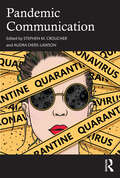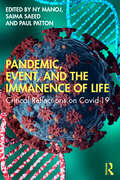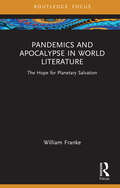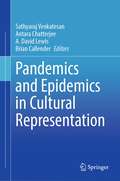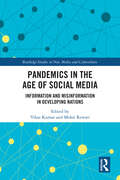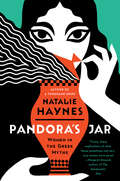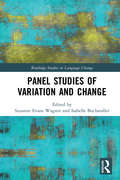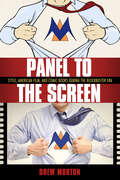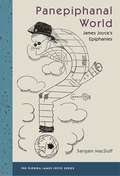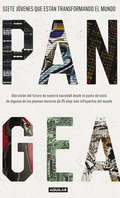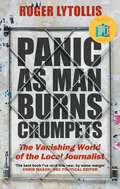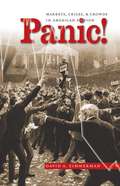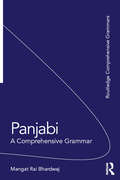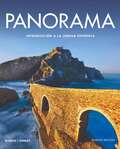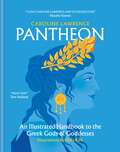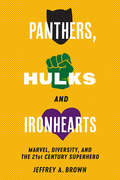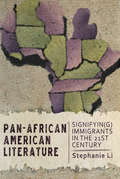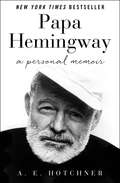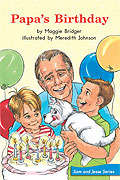- Table View
- List View
Pandemic Communication
by Stephen M. Croucher Audra Diers-LawsonThis book details how the processes of communication are affected by the presence of a pandemic and establishes a research agenda for those effects across the broad field of communication studies. Through contributions from experts in communication subdisciplines such as crisis, organizational, interpersonal, health, intergroup, and intercultural, this book provides the reader with a comprehensive view of the emerging field of study "pandemic communication." Each chapter has four primary objectives to: (1) define critical issues for pandemic communication from its subdiscipline’s perspective, (2) examine how communication varies during pandemic(s), (3) provide examples of how pandemic(s) havefor affected communication, and (4) propose a research agenda to build pandemic communication theory. This book is suited to undergraduate or post-graduate courses or modules in communication studies across a variety of subdisciplines as well as a reference for researchers in the subject.
Pandemic Health and Fitness (Routledge Studies in Health Humanities)
by Joshua O. Reno Sabina M. PerrinoThis book adopts an innovative approach in exploring the evolution of fitness practices among a community of gym goers amid a global pandemic, considering its impact on the interplay of the words, habits, and relationships gym goers use in realizing their aspirations of wellness and well-being.Perrino and Reno introduce a multilayered framework which combines insights from linguistic and sociocultural anthropology, integrating narrative analysis, discourse analysis, and ethnography, with autoethnography. This approach allows for a holistic portrait of the gym as a research site and of fitness as a fruitful area for dynamic cross-disciplinary study. The volume explores how the COVID-19 pandemic has shaped attitudes and practices around fitness, drawing on audio and video recordings and the authors’ lived experiences to analyze everything from workout choreography to micro-celebrity fitness culture to group classes. The book raises key questions around what it means to be well amid a pandemic, the practical dangers of realizing fitness goals in such times, the effects on the social relationships inherent to gym culture, and the impact on identity construction and self-reflection.This volume will appeal to scholars interested in the interdisciplinary study of fitness, in such areas as linguistic anthropology, sociocultural anthropology, health humanities, and sport studies.
Pandemic of Perspectives: Creative Re-imaginings
by Rimple Mehta Debaroti Chakraborty Sandali ThakurThis volume brings together academics, activists, social work practitioners, poets, and artists from different parts of the world during the Covid-19 pandemic. It sheds light on how the pandemic has exposed the inequities in society and is shaping social institutions, affecting human relationships, and creating new norms with each passing day. It examines how people from diverse societies and fields of work have come to conceptualise and imagine a new world order based on the principles of social and ecological justice, care, and human dignity. It prioritises the realm of imagination, creativity, and affect in understanding social formations and in shaping societies beyond the positivist approaches. Documenting the myriad experiences and responses to the pandemic, the volume foregrounds varied processes of making meaning; understanding impulses, resistances, and coping mechanisms; and building solidarities. Further, it also acts as a tool of memory for future generations, and articulations- artistic, political, socio-cultural, scientific- of hope and perseverance. This spectrum of expressions intends to value visceral experiences, build solidarities, and find solace in art. Its uniqueness lies in the way it brings together a much-needed interface between science, social sciences, and humanities. A compelling account on our contemporary lives, the volume will be of great interest to scholars of sociology and social anthropology, politics, art and aesthetics, psychology, social work, literature, health, and medical sciences.
Pandemic, Event, and the Immanence of Life: Critical Reflections on Covid-19
by Paul Patton Saima Saeed Ny ManojThis volume reflects on different regional and national experiences of the Covid 19 pandemic, with contributions from India, Thailand, Singapore, Australia, Italy, United States, and Canada.This book draws upon a number of approaches but especially the works of Deleuze and Guattari, Agamben, Derrida, Foucault, Habermas, Latour, and Serres. It looks at the methodological aspects of treating the pandemic, focuses on laying out the posthuman condition of the event largely problematizing the immanence of life which affirms the transversal Deleuzian ethic of life, and extends the politics of life to the domain of immunology. Together, the authors make it apparent that the pandemic is a multifaceted event, or many different kinds of events – virological, informational, phenomenological, social, and discursive. The authors skilfully develop these different dimensions of the pandemic event and show the relations between them. These essays will enrich the reader’s understanding of the pandemic and its effects, while demonstrating the depth and breadth of the resources that humanities scholarship can mobilize to help us understand such phenomena.This volume will be useful to students of posthumanism, medical humanities, health communication, political communication, semiotics, literature, cultural theories, and major strains of thought from contemporary continental philosophy.
Pandemics and Apocalypse in World Literature: The Hope for Planetary Salvation (Routledge Focus on Literature)
by William FrankePandemics and Apocalypse rereads classical narratives of plague from the Bible (Exodus) and classical antiquity, both Greek (Homer, Thucydides, Sophocles) and Roman (Lucretius, Virgil, Ovid), through the Middle Ages (Dante, Boccaccio) and Modernity (Defoe, Manzoni, Artaud, Camus) as a basis for contemplating the significance of the recent Covid-19 pandemic. It concerns how we are to confront future pandemics and other inextricably related crises, notably those of an ecological nature. Responses to Covid-19 typically set everything on defeating this “enemy,” but actually we cannot eliminate viruses without eliminating ourselves. We need to see the pandemic as revealing us to ourselves in our inherently vulnerable condition as a first step to admitting the infinite openness to one another and to our Ground—physical and metaphysical—that alone can save our world by engendering a different attitude, open and engaged, to one another and to the Earth as sources of our collective life.
Pandemics and Epidemics in Cultural Representation
by A. David Lewis Sathyaraj Venkatesan Antara Chatterjee Brian CallenderThis edited book analyses how artists, authors, and cultural practitioners have responded to and represented episodes of epidemics/pandemics through history. Covering a broad range of notable epidemics/pandemics (black death, cholera, Influenza, AIDS, Ebola, COVID-19), the chapters examine the cultural representations of epidemics and pandemics in different contexts, periods, languages, media, and genres. Interdisciplinary in nature and drawing on perspectives from medicine, literature, medical anthropology, philosophy of medicine, and cultural theory, the book investigates and emphasizes the urgent need to reflect on past catastrophes caused by such outbreaks. By delving into cultural history, it re-examines how societies and communities have responded in the past to species-threatening epidemics/pandemics. Sure to be of interest to lay readers as well as students and researchers, this work situates epidemics and pandemics outbreaks within the contexts of culture and narrative, and their complex and layered representation, commenting on intersections of contagion, culture, and community. It offers a cross-cultural, global, and comparative analysis of the trajectories, histories and responses to various epidemics/pandemics that impacted people worldwide.
Pandemics in the Age of Social Media: Information and Misinformation in Developing Nations (Routledge Studies in New Media and Cyberculture)
by Vikas Kumar Mohit RewariThis book offers insights into social media practices and challenges in developing nations during the COVID-19 pandemic. Covering different aspects of social media during the pandemic, the book offers new frameworks, concepts, tools and techniques for integrating social media to support national development. Thematically organized chapters from a global team of scholars address the different aspects of social media during the pandemic. The book begins by looking at ICT for development and how development agencies have used social media platforms, before looking at engagement with these social media campaigns and the spread of misinformation. Further chapters cover the practical uses of social media in healthcare and virtual medicine, mental health issues and challenges, remote education and government policies. This timely volume will be of interest to scholars and students of social media, health communication, global development studies and NGO communication.
Pandora's Jar: Women in the Greek Myths
by Natalie Haynes“Funny, sharp explications of what these sometimes not-very-nice women were up to, and how they sometimes made idiots of . . . but read on!”—Margaret Atwood, author of The Handmaid's TaleThe national bestselling author of A Thousand Ships returns with a fascinating, eye-opening take on the remarkable women at the heart of classical stories Greek mythology from Helen of Troy to Pandora and the Amazons to Medea.The tellers of Greek myths—historically men—have routinely sidelined the female characters. When they do take a larger role, women are often portrayed as monstrous, vengeful or just plain evil—like Pandora, the woman of eternal scorn and damnation whose curiosity is tasked with causing all the world’s suffering and wickedness when she opened that forbidden box. But, as Natalie Haynes reveals, in ancient Greek myths there was no box. It was a jar . . . which is far more likely to tip over. In Pandora’s Jar, the broadcaster, writer, stand-up comedian, and passionate classicist turns the tables, putting the women of the Greek myths on an equal footing with the men. With wit, humor, and savvy, Haynes revolutionizes our understanding of epic poems, stories, and plays, resurrecting them from a woman’s perspective and tracing the origins of their mythic female characters. She looks at women such as Jocasta, Oedipus’ mother-turned-lover-and-wife (turned Freudian sticking point), at once the cleverest person in the story and yet often unnoticed. She considers Helen of Troy, whose marriage to Paris “caused” the Trojan war—a somewhat uneven response to her decision to leave her husband for another man. She demonstrates how the vilified Medea was like an ancient Beyonce—getting her revenge on the man who hurt and betrayed her, if by extreme measures. And she turns her eye to Medusa, the original monstered woman, whose stare turned men to stone, but who wasn’t always a monster, and had her hair turned to snakes as punishment for being raped. Pandora’s Jar brings nuance and care to the millennia-old myths and legends and asks the question: Why are we so quick to villainize these women in the first place—and so eager to accept the stories we’ve been told?
Panel Studies of Variation and Change (Routledge Studies in Language Change)
by Isabelle Buchstaller Suzanne Evans WagnerThe relationship between the individual and the community is at the core of sociolinguistic theorizing. To date, most longitudinal research has been conducted on the basis of trend studies, such as replications of cross-sectional studies, or comparisons between present-day cross-sectional data and ‘legacy’ data. While the past few years have seen an increasing interest in panel research, much of this work has been published in a variety of formats and languages and is thus not easily accessible. This edited volume brings together the major researchers in the field of panel research, highlighting connections and convergences across and between chapters, methods and findings with the aim of initiating a dialogue about best practices and ways forward in sociolinguistic panel studies. By providing, for the first time, a platform for key research on panel data in one coherent edition, this volume aims to shape the agenda in this increasingly vibrant field of research.
Panel to the Screen: Style, American Film, and Comic Books during the Blockbuster Era
by Drew MortonOver the past forty years, American film has entered into a formal interaction with the comic book. Such comic book adaptations as Sin City, 300, and Scott Pilgrim vs. the World have adopted components of their source materials' visual style. The screen has been fractured into panels, the photographic has given way to the graphic, and the steady rhythm of cinematic time has evolved into a far more malleable element. In other words, films have begun to look like comics. Yet, this interplay also occurs in the other direction. In order to retain cultural relevancy, comic books have begun to look like films. Frank Miller's original Sin City comics are indebted to film noir while Stephen King's The Dark Tower series could be a Sergio Leone spaghetti western translated onto paper. Film and comic books continuously lean on one another to reimagine their formal attributes and stylistic possibilities. In Panel to the Screen, Drew Morton examines this dialogue in its intersecting and rapidly changing cultural, technological, and industrial contexts. Early on, many questioned the prospect of a "low" art form suited for children translating into “high” art material capable of drawing colossal box office takes. Now the naysayers are as quiet as the queued crowds at Comic-Cons are massive. Morton provides a nuanced account of this phenomenon by using formal analysis of the texts in a real-world context of studio budgets, grosses, and audience reception.
Panepiphanal World: James Joyce's Epiphanies (The Florida James Joyce Series)
by Sangam MacDuffPanepiphanal World is the first in-depth study of the forty short texts James Joyce called “epiphanies.” Composed between 1901 and 1904, at the beginning of Joyce’s writing career, these texts are often dismissed as juvenilia. Sangam MacDuff argues that the epiphanies are an important point of origin for Joyce’s entire body of work, showing how they shaped the structure, style, and language of his later writings. Tracing the ways Joyce incorporates the epiphanies into Dubliners, A Portrait of the Artist as a Young Man, Ulysses, and Finnegans Wake, MacDuff describes the defining characteristics of the epiphanies—silence and repetition, materiality and reflexivity—as a set of recurrent and inter-related tensions in the development of Joyce’s oeuvre. MacDuff uses fresh archival evidence, including a new typescript of the epiphanies that he discovered, to show the importance of the epiphanies throughout Joyce’s career. MacDuff compares Joyce’s concept of epiphany to classical, biblical, and Romantic revelations, showing that instead of pointing to divine transcendence or the awakening of the sublime, Joyce’s epiphanies are rooted in and focused on language. MacDuff argues that the Joycean epiphany is an apt characterization of modernist literature and that the linguistic forces at play in these early texts are also central to the work of Joyce’s contemporaries including Woolf, Beckett, and Eliot. A volume in the Florida James Joyce Series, edited by Sebastian D. G. Knowles An Open Access edition of this book was published with the support of the Swiss National Science Foundation.
Pangea
by Varios AutoresUna visión del futuro de nuestra sociedad desde el punto de vista de siete de los jóvenes menores de veinticinco años más influyentes del mundo. ¿Alguien escucha las voces de la generación más preparada de la historia?Definitivamente no, o al menos no lo suficiente. Nuestro mundo escucha cada día en los medios de comunicación las voces y las ideas de aquellos que dirigen nuestra sociedad, voces que llevan sonando en nuestras cabezas desde hace décadas. Pangea recoge distintas argumentaciones sobre cómo mejorar y transformar nuestra sociedad global elaboradas por siete de los jóvenes más importantes e influyentes en sus ámbitos a nivel mundial. Unas voces que no quieren pertenecer a una generación perdida sino todo lo contrario. Pablo González Ruiz de la Torre: fundador de la primera red social para el fomento del talento joven y colaborador en distintos proyectos, como Singularity Universiy, institución fundada por la NASA y Google. André Leonardo: emprendedor que ha dado la vuelta al mundo para promover la cultura portuguesa y que hoy es ya embajador de Lisboa en el mundo. Mohamed Amine: el joven más influyente de África según Huffington Post. Luis Iván Cuende: uno de los mejores programadores de Europa y fundador de tres empresas. Alec Urbach: escritor, cineasta, orador, empresario social, fundador de una escuela de animación y director de una empresa que produce cómics educativos. Katia Gómez: una de las emprendedoras sociales más influyentes de Latinoamérica. Tomás Álvarez Belón: hijo de la familia superviviente del tsunami de Tailandia de 2004 que inspiró Lo imposible y hoy un brillante estudiante de Política y Filosofía en Georgetown.
Panic as Man Burns Crumpets: The Vanishing World of the Local Journalist
by Roger Lytollis'For those who know about provincial newspapers, this will be a classic and a gem. Those who don't know will envy what they have missed' MELVYN BRAGG'Brisk and entertaining. A very readable love letter to a disappearing world, told with verve and tenderness' STUART MACONIE, author of Pies and Prejudice'Gut-bustingly funny, poignant and packed with astonishing insider information'M. W. CRAVEN, author of the award-winning The Puppet ShowYou dreamed of being a journalist and the dream has come true. You love working for your local paper . . . although not everything is as you imagined.You embarrass yourself with a range of celebrities, from John Hurt to Jordan. Your best story is 'The Man With the Pigeon Tattoo'.A former colleague interviews President Trump. You urinate in the president of the Mothers' Union's garden. Your appearance as a hard-hitting columnist on a BBC talk show does not go well. And being photographed naked is only the second most humiliating thing to happen one infamous afternoon. There are serious stories, such as a mass shooting, a devastating flood, and the search for Madeleine McCann.Meanwhile local papers are dying. Your building is crumbling and your readership is dwindling. Your carefully crafted features are read by fewer people than a story about fancy dress for dogs. Panic as Man Burns Crumpets is the inside story of local newspapers during the past twenty-five years, told in a way that's funny, poignant and revealing.
Panic as Man Burns Crumpets: The Vanishing World of the Local Journalist
by Roger Lytollis'For those who know about provincial newspapers, this will be a classic and a gem. Those who don't know will envy what they have missed' MELVYN BRAGG'Brisk and entertaining. A very readable love letter to a disappearing world, told with verve and tenderness' STUART MACONIE, author of Pies and Prejudice'Gut-bustingly funny, poignant and packed with astonishing insider information'M. W. CRAVEN, author of the award-winning The Puppet Show'Local journalism has never seemed more exotic than in this part-memoir, part-ode to that disappearing art, which is as funny as it is endearing . . . Told with a tender fondness, the bonkers, baffling but vital world of local press is paraded with the style that it deserves'JONATHAN WHITELAW, Sun'Refreshingly honest, engagingly self-deprecating, tremendously funny and more than a little heartbreaking. By far my favourite read of the year so far'MIKE WARD, TV editor, Daily Express/Daily Star 'Local publishers . . . need to hold on to thoughtful, dedicated writers such as Roger Lytollis, or his book will be an epitaph to a centuries-old industry'IAN BURRELL, i paper'Anyone who has ever worked at a local newspaper, or wondered what it is like, should read this book'DOMINIC PONSFORD, media editor at New Statesman Media Group/editor-in-chief at Press Gazette'[Lytollis] writes with clarity, comically self-effacing honesty and surprising poignancy . . . [this is] the story of what it is like to love what you do, and be great at it, and to watch it collapse around you in slow motion' ROBYN VINTER, GuardianYou dreamed of being a journalist and the dream has come true. You love working for your local paper . . . although not everything is as you imagined.You embarrass yourself with a range of celebrities, from John Hurt to Jordan. Your best story is 'The Man With the Pigeon Tattoo'.A former colleague interviews President Trump. You urinate in the president of the Mothers' Union's garden. Your appearance as a hard-hitting columnist on a BBC talk show does not go well. And being photographed naked is only the second most humiliating thing to happen one infamous afternoon. There are serious stories, such as a mass shooting, a devastating flood, and the search for Madeleine McCann.Meanwhile local papers are dying. Your building is crumbling and your readership is dwindling. Your carefully crafted features are read by fewer people than a story about fancy dress for dogs. Panic as Man Burns Crumpets is the inside story of local newspapers during the past twenty-five years, told in a way that's funny, poignant and revealing.
Panic!
by David A. ZimmermanDuring the economic depression of the 1890s and the speculative frenzy of the following decade, Wall Street, high finance, and market crises assumed unprecedented visibility in the United States. Fiction writers published scores of novels in the period that explored this new cultural phenomenon. In Panic!, David A. Zimmerman studies how American novelists and their readers imagined--and in one case, incited--market crashes and financial panics. Panic! examines how Americans' attitudes toward securities markets, popular investment, and financial catastrophe were entangled with their conceptions of gender, class, crowds, corporations, and history. Zimmerman investigates how writers turned to mob psychology, psychic investigations, and conspiracy discourse to understand not only how financial markets worked, but also how mass acts of financial reading, including novel reading, could trigger economic disaster and cultural chaos. In addition, Zimmerman shows how, by concentrating on markets in crisis, novelists were able to explore the limits of fiction's aesthetic, economic, and ethical capacities. With readings of canonical as well as lesser-known novelists, Zimmerman provides an original and wide-ranging analysis of the relation between fiction and financial modernity.
Panini
by Saroja BhateMonograph in English by Saroja Bhate on the ancient Sanskrit Grammarian.<P> This book is the story of sage Panini and his grammar told by Soma Eva in his "Kathasaritsagara". Panini, the greatest grammarian of the world, belonged to the period between 5th and 4th century B.C.
Panjabi: A Comprehensive Grammar (Routledge Comprehensive Grammars)
by Mangat BhardwajPanjabi: A Comprehensive Grammar is a complete reference guide to Panjabi grammar. It presents a fresh, accessible and thorough description of the language, concentrating on the real patterns of use in modern Panjabi. The book moves from the script and sound through morphology and word classes to a detailed analysis of sentence structures and semantic features. The volume is organized to promote a thorough understanding of Panjabi grammar. It offers a stimulating analysis of the complexities of the language, and provides full and clear explanations. Throughout, the emphasis is on Panjabi as used by present-day native speakers. An extensive index and numbered paragraphs provide readers with easy access to the information they require. Features include: detailed treatment of the common grammatical structures and parts of speech extensive exemplification particular attention to areas of confusion and difficulty Gurmukhi script and transliteration provided throughout additional chapter on the Shahmuki script Panjabi: A Comprehensive Grammar is an essential reference source for the learner and user of Panjabi. With clear and simple explanations it will remain the standard reference work for years to come for both learners and linguists alike. A Workbook and Reader to accompany this grammar can be downloaded from https://www.routledge.com/products/9781138793866. *Please note that, due to unforseen circumstances, the Workbook and Reader have been delayed.*
Panorama: Introduccion a la lengua espanola
by Philip Redwine Donley José BlancoPanorama presents vocabulary words and expressions within the context of the Fotonovela’s storyline. This exposes students to authentic conversations and situations, which makes learning vocabulary more relevant and meaningful. The Can-Do Statements set clear communicative goals for the students and encourage them to practice using the vocabulary in realistic scenarios. By incorporating lexical variations throughout every lesson, Panorama helps students gain a deeper understanding of the linguistic richness within the Spanish-speaking world and helps them appreciate the nuances among and differences between the various communities.
Panoramas and Compilations in Nineteenth-Century Britain: Seeing the Big Picture (Palgrave Studies in Nineteenth-Century Writing and Culture)
by Helen KingstoneThis book shows how in nineteenth-century Britain, confronted with the newly industrialized and urbanized modern world, writers, artists, journalists and impresarios tried to gain an overview of contemporary history. They drew on two successive but competing conceptual models of overview: the panorama and the compilation. Both models claimed to offer a holistic picture of the present moment, but took very different approaches. This book shows that panoramas (360° views previously associated with the Romantic period) and compilations (big data projects previously associated with the Victorian fin de siècle) are intertwined, relevant across the entire century, and often remediated, making them crucial lenses through which to view a broad range of genre and forms. It brings together interdisciplinary research materials belonging to different period silos to create new understandings of how nineteenth-century audiences dealt with information overload. It argues for a new politics of distance: one that recognizes the value of immersing oneself in a situation, event or phenomenon, but which also does not chastise us for trying to see the big picture. This book is essential reading for students and scholars of nineteenth-century literature, history, visual culture and information studies.
Pantheon: An Illustrated Handbook to the Greek Gods & Goddesses
by Caroline Lawrence***'I love Caroline Lawrence and so should you.' Natalie Haynes'Huge fun!' Tom Holland'Gorgeous illustrations bring the whole pantheon to life.' Emily Wilson***EXPLORE THE MYTHICAL PAST, MEET THE ANCIENT GREEK GODS AND GODDESSES AND DISCOVER WHY THEIR STORIES ARE STILL SO ENTHRALLING TODAY...Have you ever wondered what the Eleusinian Mysteries were? Unsure whether Aphrodite ends up with Hephaestus or with Ares? Want to know how to identify each of the nine Muses? Whether you're already well versed in the lore, or are discovering these tales for the first time, this handbook is your ultimate companion to the characters from Greek myth. Informed by sources ranging from Homer and Hesiod's poetry to Athenian drama, and from 5th century BCE Greek vases to Roman statues, bestselling author and classicist Caroline Lawrence provides insightful profiles for each god, demigod, hero and monster. Learn the origin stories and best-known myths of each deity, as well as their attributes and how to identify them in art.
Pantheon: An Illustrated Handbook to the Greek Gods & Goddesses
by Caroline Lawrence***'I love Caroline Lawrence and so should you.' Natalie Haynes'Huge fun!' Tom Holland'Gorgeous illustrations bring the whole pantheon to life.' Emily Wilson***EXPLORE THE MYTHICAL PAST, MEET THE ANCIENT GREEK GODS AND GODDESSES AND DISCOVER WHY THEIR STORIES ARE STILL SO ENTHRALLING TODAY...Have you ever wondered what the Eleusinian Mysteries were? Unsure whether Aphrodite ends up with Hephaestus or with Ares? Want to know how to identify each of the nine Muses? Whether you're already well versed in the lore, or are discovering these tales for the first time, this handbook is your ultimate companion to the characters from Greek myth. Informed by sources ranging from Homer and Hesiod's poetry to Athenian drama, and from 5th century BCE Greek vases to Roman statues, bestselling author and classicist Caroline Lawrence provides insightful profiles for each god, demigod, hero and monster. Learn the origin stories and best-known myths of each deity, as well as their attributes and how to identify them in art.
Panthers, Hulks and Ironhearts: Marvel, Diversity and the 21st Century Superhero
by Jeffrey A. BrownMarvel is one of the hottest media companies in the world right now, and its beloved superheroes are all over film, television and comic books. Yet rather than simply cashing in on the popularity of iconic white male characters like Peter Parker, Tony Stark and Steve Rogers, Marvel has consciously diversified its lineup of superheroes, courting controversy in the process. Panthers, Hulks, and Ironhearts offers the first comprehensive study of how Marvel has reimagined what a superhero might look like in the twenty-first century. It examines how they have revitalized older characters like Black Panther and Luke Cage, while creating new ones like Latina superhero Miss America. Furthermore, it considers the mixed fan responses to Marvel’s recasting of certain “legacy heroes,” including a Pakistani-American Ms. Marvel, a Korean-American Hulk, and a whole rainbow of multiverse Spidermen. If the superhero comic is a quintessentially American creation, then how might the increasing diversification of Marvel’s superhero lineup reveal a fundamental shift in our understanding of American identity? This timely study answers those questions and considers what Marvel’s comics, TV series, and films might teach us about stereotyping, Orientalism, repatriation, whitewashing, and identification.
Pan–African American Literature: Signifyin(g) Immigrants in the Twenty-First Century
by Stephanie LiThe twenty-first century is witnessing a dynamic broadening of how blackness signifies both in the U.S. and abroad. Literary writers of the new African diaspora are at the forefront of exploring these exciting approaches to what black subjectivity means. Pan-African American Literature is dedicated to charting the contours of literature by African born or identified authors centered around life in the United States. The texts examined here deliberately signify on the African American literary canon to encompass new experiences of immigration, assimilation and identification that challenge how blackness has been previously conceived. Though race often alienates and frustrates immigrants who are accustomed to living in all-black environments, Stephanie Li holds that it can also be a powerful form of community and political mobilization.
Papa Hemingway: A Personal Memoir
by A. E. HotchnerAn intimate, joy-filled portrait and New York Times bestseller, written by one of Hemingway’s closest friends: “It is hard to imagine a better biography” (Life). In 1948, A. E. Hotchner went to Cuba to ask Ernest Hemingway to write an article on “The Future of Literature” for Cosmopolitan magazine. The article never materialized, but from that first meeting at the El Floridita bar in Havana until Hemingway’s death in 1961, Hotchner and the Nobel and Pulitzer Prize–winning author developed a deep and abiding friendship. They caroused in New York City and Rome, ran with the bulls in Pamplona, hunted in Idaho, and fished the waters off Cuba. Every time they got together, Hemingway held forth on an astonishing variety of subjects, from the art of the perfect daiquiri to Paris in the 1920s to his boyhood in Oak Park, Illinois. Thankfully, Hotchner took it all down. Papa Hemingway provides fascinating details about Hemingway’s daily routine, including the German army belt he wore and his habit of writing descriptive passages in longhand and dialogue on a typewriter, and documents his memories of Gertrude Stein, F. Scott Fitzgerald, Martha Gellhorn, Marlene Dietrich, and many of the twentieth century’s most notable artists and celebrities. In the literary icon’s final years, as his poor health began to affect his work, Hotchner tenderly and honestly portrays Hemingway’s valiant attempts to beat back the depression that would lead him to take his own life. Deeply compassionate and highly entertaining, this “remarkable” New York Times bestseller “makes Hemingway live for us as nothing else has done” (The Wall Street Journal).
Papa's Birthday (Fountas & Pinnell LLI Green #Level G, Lesson 73)
by Maggie BridgerFountas and Pinnell Leveled Literacy Intervention Green System -- 1st Grade
